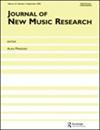就职社论
IF 0.9
4区 计算机科学
Q4 COMPUTER SCIENCE, INTERDISCIPLINARY APPLICATIONS
引用次数: 0
摘要
我们很高兴接任《新音乐研究杂志》的编辑。我们想在这篇社论的第一期开始时感谢Alan Marsden近二十年来对该杂志的出色管理。在他的任期内,他监督将之前的四期扩大到每年五期,从而允许每年发表更多的文章。通过这一行动和其他编辑行动,该杂志的读者人数有所增加,全文下载量从2005年的3554次增加到2022年的51999次。Alan还保护并扩大了该杂志的跨学科遗产,出版了一系列学科方向的高质量作品,包括音乐学、作曲、心理学和计算。随着我们以新的编辑身份进入该杂志的新时代,我们想重申我们的承诺,即保持该杂志作为创新和实证研究的深入报道之家,同时探索如何扩大该杂志的多样性。我们认识到,学术界作为一个整体正在与多样性、公平性和包容性问题作斗争,这引发了谁的作品正在出版、谁的声音正在被纳入话语以及谁的文化正在被研究的问题。我们致力于在所涉及的音乐传统范围和所采用的方法方面使内容多样化,同时忠实于该杂志的既定目标和范围。我们还旨在从地理范围、作者的背景和身份等方面扩大该杂志的影响力和相关性。除了使期刊上发表的论文多样化,我们还将努力更新和多样化编委会和审稿人库。因此,我们欢迎相关研究团体的成员以这两种身份为该杂志的未来做出贡献。在本期中,我们很高兴能够介绍五项引人入胜的研究,涉及广泛的主题,包括击鼓表演实践、声音雕塑、计算机辅助配器和音乐生成。第一篇论文由奥斯陆大学RITMO节奏、时间和运动跨学科研究中心的Guilherme Schmidt Câmara、George Sioros和Anne Danielsen撰写。这项研究表明,鼓手在表达简单的“后拍”模式时,在区分悠闲或推挤与节拍上的表演时,会采用三种通用策略之一。作者分析了鼓手表演中出现不同类型的发作异步和强度的相对频率,并表明使用层次聚类可以将表演分类为三个发作和强度原型,这些原型使用系统发育树进行可视化。在本期的第二篇论文中,布宜诺斯艾利斯国家奎尔姆斯大学的Leonardo Salzano和Manuel C.Eguia展示了一个迷人的音乐声音雕塑,名为IRIS。IRIS由两个直径1.8米的周期性穿孔圆盘组成,圆盘独立旋转,基于声学双渔网结构。IRIS作为一个纯声学的空间滤波器,对输入声音的谐波进行调制,以在不同的方向上传输不同的音色。作者介绍了两种音乐应用,展示了IRIS如何在表演场景中以可控的方式修改声源的音色和空间性。本期的第三篇论文由加州大学伯克利分校新音乐与音频技术中心(CNMAT)音乐系的Carmine Emanuele Cella撰写。Cella专注于基于目标的计算机辅助编排问题,并提出了一个新的计算框架来解决这个问题,称为Orchidea。基于目标的编排问题包括发现声学乐器声音的组合,当这些声音一起演奏时,会产生尽可能类似于某些预定义目标声音的声音。不幸的是,为了找到最接近目标的解决方案,对仪器和音高的所有组合进行迭代的天真解决方案需要样本数据库大小的指数级时间,因此不实用。还有其他困难的问题需要解决,例如测量候选声音和目标声音之间的感知距离以及定义与编排任务相关的特征。Orchidea系统试图通过使用两阶段算法来解决这些问题,该算法使用半贪婪搜索对解决方案进行初步估计,然后通过单目标进化优化对其进行改进。本文章由计算机程序翻译,如有差异,请以英文原文为准。
Inaugural editorial
We are delighted to take over the editorship of the Journal of New Music Research. We would like to start this editorial to our first issue by thanking Alan Marsden for his excellent stewardship of the journal for nearly two decades. During his tenure, he oversaw the expansion to five issues a year from its previous four, allowing for a greater range of articles to be published each year. Through this and other editorial actions, the readership of the journal grew, with full-text downloads increasing from 3,554 in 2005 to 51,999 in 2022. Alan also guarded and expanded the journal’s interdisciplinary legacy, publishing high-quality work from a range of disciplinary orientations, including musicological, compositional, psychological, and computational. As we enter a new era for the journal with new editorship, we would like to reaffirm our commitment to maintaining the journal as a home for in-depth reports on research that is innovative and empirically grounded, while also exploring how we can broaden the journal’s diversity. We recognise that academia as a whole is strugglingwith issues of diversity, equity, and inclusion, raising questions as to whose work is being published, whose voice is being included in the discourse, and whose culture is being studied. We are dedicated to diversifying both the content in terms of the range of musical traditions engaged with, as well as the methodologies adopted, while keeping true to the journal’s stated aims and scope. We also aim to broaden the reach and relevance of the journal in terms of its geographical range and the backgrounds and identities of the authors. In addition to diversifying the papers published in the journal, we will also be working towards refreshing and diversifying the editorial board and reviewer pools. So we welcome offers frommembers of the relevant research communities to contribute to the journal’s future in either of these capacities. In this issue, we are very pleased to be able to present five fascinating studies on a broad range of topics, including drumming performance practice, sound sculptures, computer-assisted orchestration and music generation. The first paper is by Guilherme Schmidt Câmara, George Sioros and Anne Danielsen from the RITMO Centre for Interdisciplinary Studies in Rhythm, Time and Motion at the University of Oslo. This study reveals that drummers adopt one of three general strategies when differentiating laid-back or pushed from on-beat performances when expressing a simple ‘back-beat’ pattern. The authors analyse the relative frequencies with which different types of onset asynchronies and intensities occur in the drummers’ performances, and show that performances can be classified using hierarchical clustering into three onset and intensity archetypes that are visualised using phylogenetic trees. In the second paper in this issue, Leonardo Salzano and Manuel C. Eguia from the Universidad Nacional de Quilmes in Buenos Aires, present a fascinating musical sound sculpture, called IRIS. IRIS consists of two 1.8m diameter, periodically perforated disks with independent rotation, based on an acoustic double-fishnet structure. IRIS acts as a purely acoustic, spatial filter that modulates the harmonics of an input sound to transmit different timbres in different directions. The authors present two musical applications, showing how IRIS can be used to modify in a controlled way the timbre and spatiality of acoustic sources in a performance situation. The third paper in this issue is by Carmine-Emanuele Cella from the Center for New Music and Audio Technologies (CNMAT)/Department of Music at the University of California, Berkeley. Cella focuses on the problem of target-based computer-assisted orchestration and presents a new computational framework to solve this problem called Orchidea. The target-based orchestration problem consists of discovering a combination of acoustic instrument sounds that, when played together, create a sound that is as similar as possible to some predefined target sound. Unfortunately, the naïve solution of iterating over all combinations of instruments and pitches in order to find the solution that is closest to the target takes time exponential in the size of the sample database and is therefore not practical. There are also other difficult problems to solve such as measuring the perceptual distance between a candidate sound and the target sound and defining features that are relevant for the orchestration task. The Orchidea system attempts to solve these problems by using a two-stage algorithm that performs a preliminary estimation of the solutions using semi-greedy search, and then improves them by mono-objective evolutionary optimisation.
求助全文
通过发布文献求助,成功后即可免费获取论文全文。
去求助
来源期刊

Journal of New Music Research
工程技术-计算机:跨学科应用
CiteScore
3.20
自引率
0.00%
发文量
5
审稿时长
>12 weeks
期刊介绍:
The Journal of New Music Research (JNMR) publishes material which increases our understanding of music and musical processes by systematic, scientific and technological means. Research published in the journal is innovative, empirically grounded and often, but not exclusively, uses quantitative methods. Articles are both musically relevant and scientifically rigorous, giving full technical details. No bounds are placed on the music or musical behaviours at issue: popular music, music of diverse cultures and the canon of western classical music are all within the Journal’s scope. Articles deal with theory, analysis, composition, performance, uses of music, instruments and other music technologies. The Journal was founded in 1972 with the original title Interface to reflect its interdisciplinary nature, drawing on musicology (including music theory), computer science, psychology, acoustics, philosophy, and other disciplines.
 求助内容:
求助内容: 应助结果提醒方式:
应助结果提醒方式:


